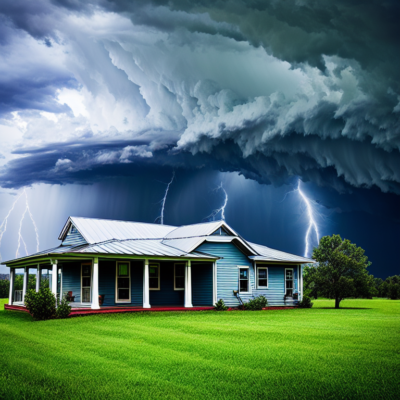Preparing For Showings During Summer Storms
A preparation guide if you have showings booked and a storm is coming.
Ensuring a positive impression on potential buyers is crucial when selling your home, regardless of the weather conditions. Extreme weather, such as heavy rain or scorching heat, can present unique challenges. This guide, “Preparing For Showings During Summer Storms,” will provide essential tips and strategies to prepare your home for showings during extreme weather effectively. From bracing for heavy rain to keeping your home comfortable during a heatwave, we will cover various topics to ensure you are well-prepared.
>>>> Watch Us On YouTube
>>>> Follow Us On Instagram
>>>> Find Us On Facebook
MORE BLOG POSTS HERE >>>>Elevate Blog
Preparing for Showings During Heavy Rain:
- Clearing gutters and downspouts: Clean your gutters and downspouts before heavy rainfall to ensure proper drainage and prevent water overflow.
- Checking for leaks: Inspect your roof, windows, and doors for any leaks. Addressing potential leaks beforehand will help keep your home dry during heavy rainfall.
- Ensuring proper drainage: Evaluate the slope of your yard and ensure that water is diverted away from your home’s foundation. Consider installing a French drain system if necessary.
- Providing entrance protection: Place a sturdy doormat outside your front door and offer an umbrella stand to accommodate visitors’ wet belongings. Consider placing rugs or mats in high-traffic areas to prevent slipping.
- Preparing for wet foot traffic: Provide extra towels to dry off surfaces quickly and minimize tracking water throughout your home.
- Showcasing waterproof features: Highlight any waterproofing measures in your home, such as a sump pump or basement waterproofing, to assure buyers of its resilience against heavy rain.
Maintaining Comfort during Extreme Heat:
- Keeping the air conditioning running smoothly: Regularly service and maintain your air conditioning system to ensure optimal performance during heat waves. Consider programmable thermostats to regulate temperature efficiently.
- Enhancing air circulation: Use ceiling and portable fans strategically to improve air circulation throughout your home. Consider utilizing cross-ventilation by opening windows and doors to create a refreshing breeze.
- Providing shade and cool spaces: Install awnings, shade sails, or patio umbrellas to create shaded areas outdoors. Indoors, use curtains or blinds to block direct sunlight and keep rooms cooler.
- Offering refreshing amenities: Consider providing chilled water bottles or refreshments to potential buyers to relieve the heat.
- Highlighting energy-efficient features: Showcase energy-saving elements in your home, such as energy-efficient windows, insulation, or smart thermostats, emphasizing their role in maintaining a comfortable indoor environment.
- Keeping the exterior cool: Opt for light-coloured paints or coatings for your home’s exterior to reflect sunlight and reduce heat absorption.
Managing Humidity with a Dehumidifier:
- Selecting the right dehumidifier: Evaluate the size and needs of each space to choose an appropriate dehumidifier. Opt for energy-efficient models with adjustable settings and automatic shutoff features.
- Identifying problem areas: Determine areas prone to excess humidity, such as basements, bathrooms, or laundry rooms. Place dehumidifiers strategically to maintain optimal humidity levels.
- Regular maintenance: Follow the manufacturer’s instructions to clean and maintain your dehumidifier effectively. Empty the water tank regularly, clean or replace filters, and ensure proper drainage.
- Controlling musty odours: Use odour-absorbing products or natural remedies like baking soda or activated charcoal to keep your home smelling fresh and pleasant, even in humid conditions.
- Ensuring proper ventilation: Open windows and use exhaust fans in kitchens and bathrooms to remove excess moisture and prevent humidity buildup.

>>>> Watch Us On YouTube
>>>> Follow Us On Instagram
>>>> Find Us On Facebook
MORE BLOG POSTS HERE >>>>Elevate Blog
Safety Measures during Extreme Weather:
- Securing outdoor furniture and objects: Strong winds or heavy rain can damage or displace outdoor furniture and other objects. Secure or store them indoors to prevent potential hazards.
- Checking the stability of trees and branches: Inspect trees on your property for weak or overhanging branches that could pose a risk during extreme weather. Trim or remove them to minimize damage to your home or visitors.
- Ensuring proper lighting: Adequate exterior lighting is essential during extreme weather conditions. Verify that all outdoor lights are functioning correctly and replace any burnt-out bulbs. This will enhance safety and visibility for potential buyers visiting your home.
Protecting Your Home’s Exterior:
- Inspecting and repairing the roof: Conduct a thorough inspection of your roof to identify any loose or damaged shingles. Replace them promptly to prevent leaks during heavy rain or windstorms.
- Sealing windows and doors: Check for gaps or cracks around windows and doors and seal them with weatherstripping or caulk to prevent drafts and water infiltration.
- Reinforcing fences and gates: Inspect fences and gates to ensure they are sturdy and secure. Reinforce weak areas or repair any damage to withstand strong winds.
- Securing outdoor structures: If you have sheds, gazebos, or other outdoor structures, ensure they are properly anchored and secured to prevent damage or displacement during extreme weather.
- Protecting outdoor surfaces: Apply weather-resistant coatings or sealants to protect decks, patios, and other outdoor surfaces from heavy rain or intense sunlight.
Emergency Preparedness:
- Creating an emergency kit: Assemble an emergency kit containing essential supplies, such as flashlights, batteries, a first aid kit, non-perishable food, and water. Store it in a readily accessible location in case of power outages or extreme weather events.
- Establishing a communication plan: Develop a communication plan with your family or neighbours in emergencies. Share important contact information and establish a designated meeting place if necessary.
- Familiarizing yourself with emergency procedures: Research local procedures and protocols, such as evacuation routes or designated storm shelters. Share this information with potential buyers to ensure their safety and peace of mind.
In Conclusion
Preparing your home for showings during extreme weather requires careful planning and proactive measures. By following the comprehensive tips in this guide, you can create a safe and comfortable environment for potential buyers, regardless of the weather conditions. From addressing heavy rain and extreme heat to managing humidity and ensuring safety, these preparations will enhance the appeal and resilience of your home. By showcasing your home’s ability to withstand and adapt to extreme weather, you can instill confidence in potential buyers and make a lasting impression.

Elevate Real Estate Group
Happy Home Buying or Selling
Are you thinking of making a move soon?
How can we elevate your real estate experience?
Potential Next Steps >>>
- Get a FREE online home evaluation: Free Home Evaluation
- Book a free in-home consultation: Contact Us
- Learn more about Elevate Real Estate Group: About Us
- Could you leave us a Google Review: Google Review
Want more details on the current market? You can find more information about the current market here: London & St Thomas Association of Realtors.



